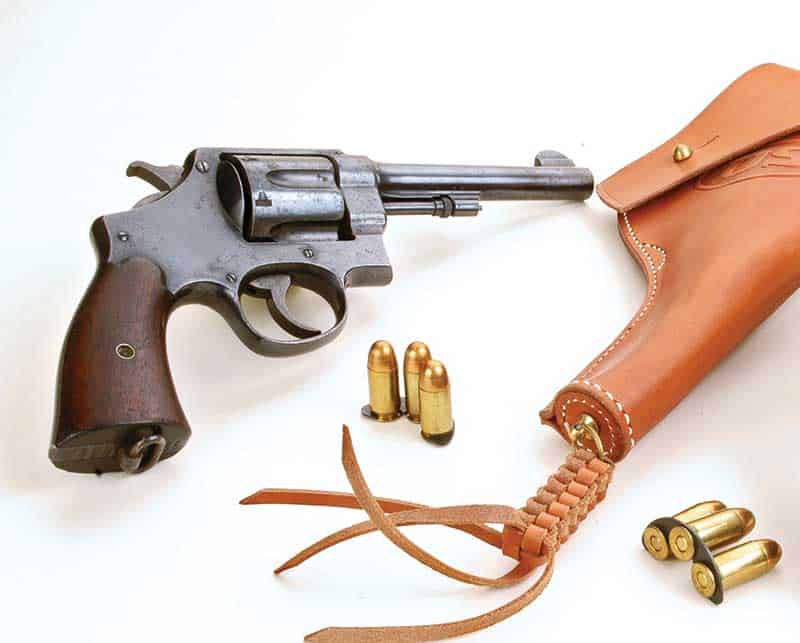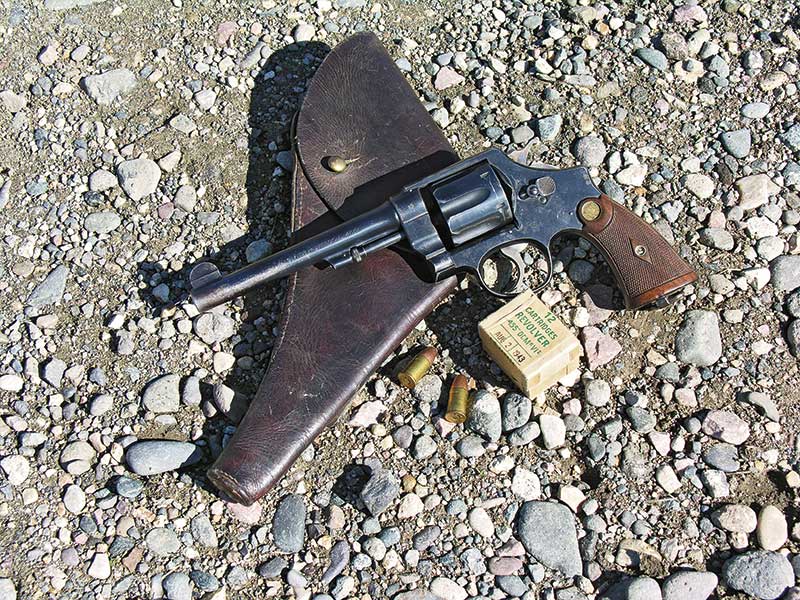All of those had 6-1/2-inch barrels, full blue finish except for the color case hardened trigger and hammer and a lanyard ring on the butt. Grips were checkered walnut and sights were S&W’s trademark “half-moon” front with groove in the frame’s topstrap for a rear. I have a sample in my collection that factory letters to the Canadian Government in 1916.
Even so, the military duty of Hand Ejector, 2nd Models was just beginning. Being almost as bad as the British for declaring war while lacking weapons, the United States entered WWI in April 1917. The US Army was desperate for handguns, so S&W was contracted to provide N-Frame revolvers altered to function with rimless .45 ACP cartridges—this was done by snapping the cases into little 3-round spring-steel clips. The Hand Ejector, 2nd Models were given the military designation of Model 1917. All were fitted with 5-1/2-inch barrels, lanyard rings and smooth walnut grips. Finish and sights were the same as for the Brit’s contract revolvers.
Production of Model 1917’s was enormous. Jinks’ book says 163,476 were made for the US Government in their own serial number range. Those are marked “United States Property” under their barrels as mine is. After WWI ended the company kept this model in their catalog until 1949 and produced about another 50,000. This order included 25,000 sold to the Brazilian Government in the late 1930’s, with many of those returning to the United States for the surplus market in the 1980’s. The commercially made Model 1917’s had checkered walnut grips instead of the military’s plain ones.
Smith & Wesson’s Hand Ejector 2nd Model
Born In War, This Jewel Is Often
Overshadowed By The 1st And 3rd Models

The first N-Frame was the Smith & Wesson Hand Ejector, 1st Model, often called the “Triple Lock” (left)
and this one is a rare target model. It was replaced at the behest of the British during WWI with the Hand
Ejector, 2nd Model, which never got a nickname. Both of these are .44 Specials. Photos By Yvonne Venturino
It seems like we older gun’riters are forever fawning over the legendary Smith & Wesson “Triple Lock” which incidentally is called Hand Ejector, 1st Model by collectors. Perhaps it is because besides being the very first of S&W’s N-Frames sixguns, the Triple Lock was also the introductory vehicle for the .44 Smith & Wesson Special.
Then there is the Hand Ejector, 3rd Model also nicknamed Model 1926. Later the Hand Ejector 4th Model was introduced. It was divided into two variations with the names of 1950 Military for the fixed sight version and 1950 Target for ones with adjustable sights.
But what about the Hand Ejector, 2nd Model? It is seldom mentioned, never got a name and was just as good a revolver as the above mentioned ones and actually far more historical.
This particular handgun was introduced 100 years ago during World War I. The Brits got themselves enmeshed in Europe’s continental war, and as usual, were short of weapons. They contracted with S&W to alter the Hand Ejector, 1st Model to accommodate their rather puny .455 Webley ammunition, but wanted changes. They said that battlefield mud and debris would foul its special 3rd lock and the ejector rod’s protective shroud.
Perhaps more importantly S&W felt the Hand Ejector, 1st models were too expensive at $21. By removing the ejector rod’s shroud and the intricately machined 3rd lock on the crane they could reduce retail price to $19.
And so was born the Hand Ejector, 2nd Model. For the American market the primary caliber offered was .44 Special. Also some were made as .38-40, .44-40 and .45 Colt but they numbered only in the hundreds each. According to Roy Jinks’ History of Smith & Wesson, by September 1916 the company had produced 74,755 N-Frame revolvers in .455 caliber for the British. Of those, 69,755 were Hand Ejector, 2nd Models. The other 5,000 were Hand Ejector, 1st Models because the British didn’t want to wait for the changes being made to the 2nd model.
And that brings us back to the Hand Ejector, 2nd Model .44 Special. In nobody’s world could it be called a big selling item. It was dropped from the S&W catalog in 1940, and again referring to Jinks’ authoritative book, only 17,510 were sold in 25 years.
Barrel lengths offered were 4, 5 and 6-1/2 inches with full blue or full nickel for finish. Some were fitted with target sights but the vast majority had sights as described for the .455 variation. Grips were checkered walnut and lanyard rings were not standard. As interested as I have always been in N-Frame S&W handguns, I have never seen a Hand Ejector, 2nd Model in any barrel length but 6-1/2 inches, any finish but blue, any type of sights but fixed or any .38-40, .44-40, or .45 Colt chambering. (Original chambering that is. Many .455’s were rechambered to .45 Colt in bygone years.)
Nigh on 20 years ago I wandered into a nifty little gun store on a trip to Los Angeles. To my utter amazement, in the handgun case was a Hand Ejector, 2nd Model .44 Special, blue finish with 6-1/2-inch barrel. I paid for it and made arrangements for it to be (legally) shipped back to Montana. It took me years to get around to factory lettering it but upon doing so I learned it had been sent to Charleston, W. Va., in 1929. Having been born and raised in that state, the provenance of this revolver dictates I keep it forever.
Besides, it shoots pretty good!





